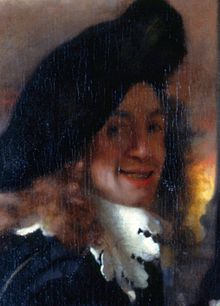Our website is made possible by displaying online advertisements to our visitors.
Please consider supporting us by disabling your ad blocker.
Johannes Vermeer
Johannes Vermeer | |
|---|---|
 | |
| Born | Joannis Vermeer baptised 31 October 1632 |
| Died | 15 December 1675 (aged 43) Delft, County of Holland, Dutch Republic |
| Known for | Painting |
| Notable work | 34 works universally attributed[2] |
| Movement | Dutch Golden Age Baroque |
| Spouse | Catharina Bolnes |
| Signature | |
 | |
Johannes Vermeer (/vərˈmɪər, vərˈmɛər/; Dutch: [vərˈmeːr], see below; also known as Jan Vermeer; October 1632 – 15 December 1675) was a Dutch painter who specialized in domestic interior scenes of middle-class life. He is considered one of the greatest painters of the Dutch Golden Age. During his lifetime, he was a moderately successful provincial genre painter, recognized in Delft and The Hague. He produced relatively few paintings, primarily earning his living as an art dealer. He was not wealthy; at his death, his wife was left in debt.[3]
Vermeer worked slowly and with great care, and frequently used very expensive pigments. He is particularly renowned for making masterful use of light in his work.[4] "Almost all his paintings", Hans Koningsberger wrote, "are apparently set in two smallish rooms in his house in Delft; they show the same furniture and decorations in various arrangements and they often portray the same people, mostly women."[5]
The modest celebrity he enjoyed during his life gave way to obscurity after his death. He was barely mentioned in Arnold Houbraken's major source book on 17th-century Dutch painting (Grand Theatre of Dutch Painters and Women Artists, published 1718) and, as a result, was omitted from subsequent surveys of Dutch art for nearly two centuries.[6][a] In the 19th century, Vermeer was rediscovered by Gustav Friedrich Waagen and Théophile Thoré-Bürger, who published an essay attributing 66 pictures to him, although only 34 paintings are universally attributed to him today.[2] Since that time, Vermeer's reputation has grown enormously.
- ^ Boone, Jon. "The Procuress: Evidence for a Vermeer Self-Portrait". Essential Vermeer. Retrieved 13 September 2010.
- ^ a b Janson, Jonathan. "Complete Vermeer Catalogue & Tracker". Essential Vermeer. Retrieved 16 June 2010.
- ^ Cite error: The named reference
Bulfinchwas invoked but never defined (see the help page). - ^ Cite error: The named reference
Wadumwas invoked but never defined (see the help page). - ^ Koningsberger, Hans (1977). The World of Vermeer. New York, USA: Time-Life Books. OCLC 755281576.
- ^ Barker, Emma; et al. (1999). The Changing Status of the Artist. New Haven: Yale University Press. p. 199. ISBN 0-300-07740-8.
- ^ Blankert, Albert (2007). "Vermeer and his Public". In Blankert, Albert; Montias, John Michael; Aillaud, Gilles (eds.). Vermeer. New York, USA: Overlook. p. 164. ISBN 978-1-58567-979-9.
Cite error: There are <ref group=lower-alpha> tags or {{efn}} templates on this page, but the references will not show without a {{reflist|group=lower-alpha}} template or {{notelist}} template (see the help page).
Previous Page Next Page


